BSBPMG530 Manage Project Scope: Project Planning and Closure Task
VerifiedAdded on 2023/06/15
|69
|11580
|226
Practical Assignment
AI Summary
This document presents a solved practical assignment for BSBPMG530 Manage Project Scope, detailing the processes involved in project scope management, from project authorization and planning to implementation, monitoring, and closure. The assessment workbook includes instructions, competency-based assessment principles, and specific tasks related to developing project authorization procedures, confirming governance arrangements, identifying project boundaries, documenting scope management plans, validating project scope, monitoring scope changes, and identifying scope management issues. It emphasizes the importance of valid, sufficient, authentic, and current evidence in assessing competency, aligning with the principles of assessment and rules of evidence in vocational education and training. The assignment is structured into three parts: Project Planning, Project Implementation and Monitoring, and Project Closure, providing a comprehensive overview of managing project scope within a workplace or simulated environment.

© Compliant Learning Resources Page 1
Paraphrase This Document
Need a fresh take? Get an instant paraphrase of this document with our AI Paraphraser
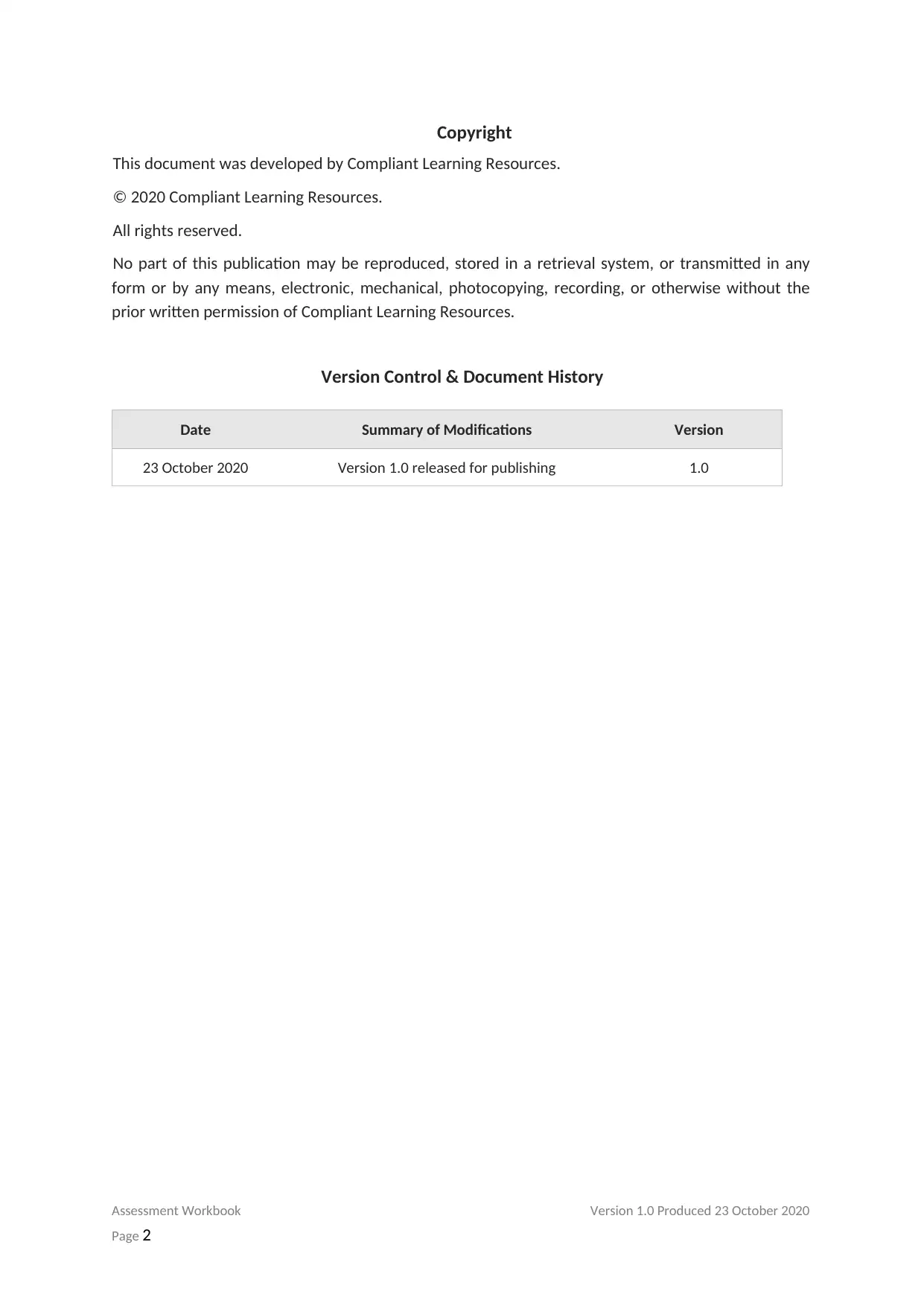
Copyright
This document was developed by Compliant Learning Resources.
© 2020 Compliant Learning Resources.
All rights reserved.
No part of this publication may be reproduced, stored in a retrieval system, or transmitted in any
form or by any means, electronic, mechanical, photocopying, recording, or otherwise without the
prior written permission of Compliant Learning Resources.
Version Control & Document History
Assessment Workbook Version 1.0 Produced 23 October 2020
Page 2
Date Summary of Modifications Version
23 October 2020 Version 1.0 released for publishing 1.0
This document was developed by Compliant Learning Resources.
© 2020 Compliant Learning Resources.
All rights reserved.
No part of this publication may be reproduced, stored in a retrieval system, or transmitted in any
form or by any means, electronic, mechanical, photocopying, recording, or otherwise without the
prior written permission of Compliant Learning Resources.
Version Control & Document History
Assessment Workbook Version 1.0 Produced 23 October 2020
Page 2
Date Summary of Modifications Version
23 October 2020 Version 1.0 released for publishing 1.0
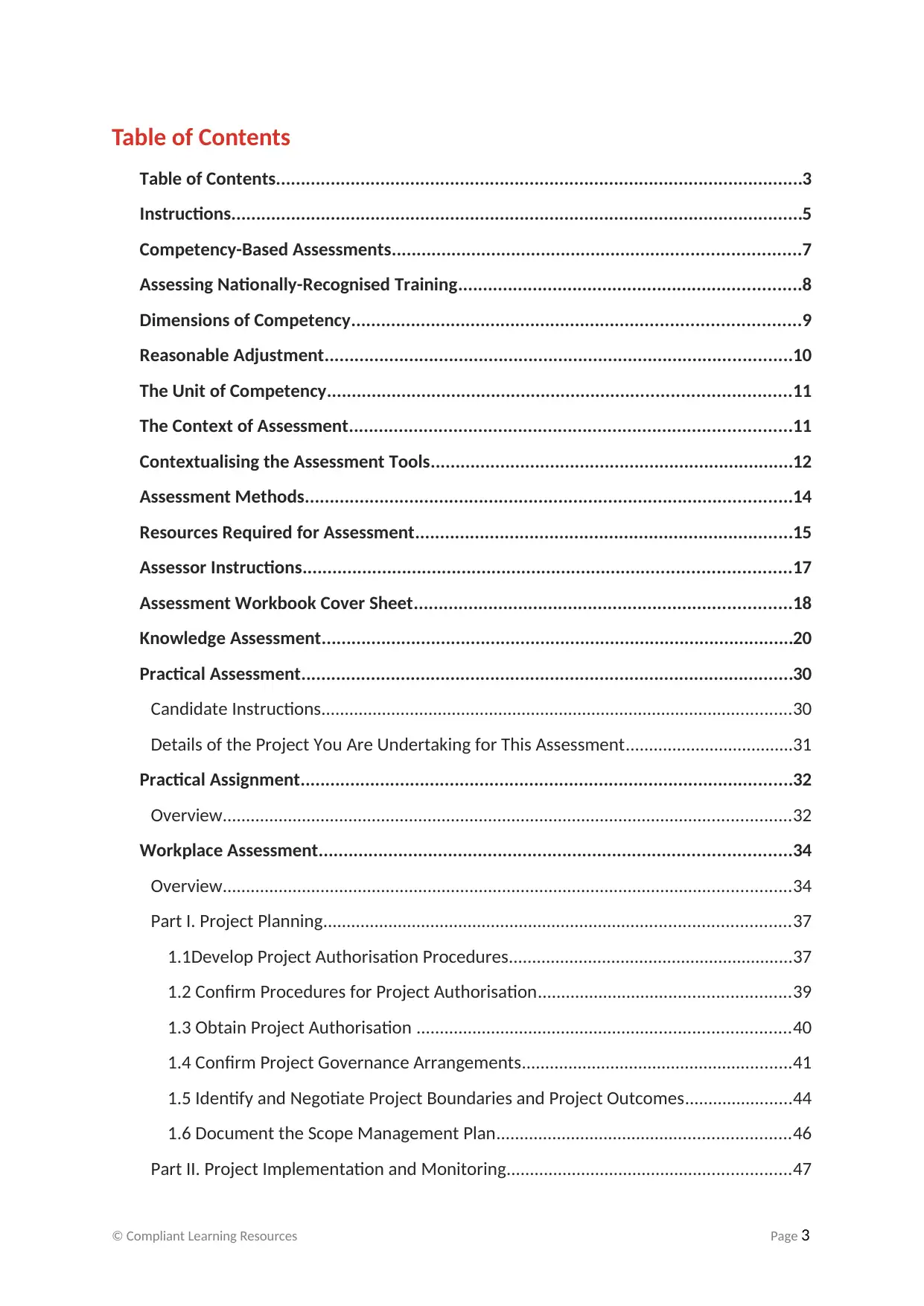
Table of Contents
Table of Contents..........................................................................................................3
Instructions...................................................................................................................5
Competency-Based Assessments..................................................................................7
Assessing Nationally-Recognised Training.....................................................................8
Dimensions of Competency..........................................................................................9
Reasonable Adjustment..............................................................................................10
The Unit of Competency.............................................................................................11
The Context of Assessment.........................................................................................11
Contextualising the Assessment Tools.........................................................................12
Assessment Methods..................................................................................................14
Resources Required for Assessment............................................................................15
Assessor Instructions..................................................................................................17
Assessment Workbook Cover Sheet............................................................................18
Knowledge Assessment...............................................................................................20
Practical Assessment...................................................................................................30
Candidate Instructions.....................................................................................................30
Details of the Project You Are Undertaking for This Assessment....................................31
Practical Assignment...................................................................................................32
Overview..........................................................................................................................32
Workplace Assessment...............................................................................................34
Overview..........................................................................................................................34
Part I. Project Planning....................................................................................................37
1.1Develop Project Authorisation Procedures.............................................................37
1.2 Confirm Procedures for Project Authorisation......................................................39
1.3 Obtain Project Authorisation ................................................................................40
1.4 Confirm Project Governance Arrangements..........................................................41
1.5 Identify and Negotiate Project Boundaries and Project Outcomes.......................44
1.6 Document the Scope Management Plan...............................................................46
Part II. Project Implementation and Monitoring.............................................................47
© Compliant Learning Resources Page 3
Table of Contents..........................................................................................................3
Instructions...................................................................................................................5
Competency-Based Assessments..................................................................................7
Assessing Nationally-Recognised Training.....................................................................8
Dimensions of Competency..........................................................................................9
Reasonable Adjustment..............................................................................................10
The Unit of Competency.............................................................................................11
The Context of Assessment.........................................................................................11
Contextualising the Assessment Tools.........................................................................12
Assessment Methods..................................................................................................14
Resources Required for Assessment............................................................................15
Assessor Instructions..................................................................................................17
Assessment Workbook Cover Sheet............................................................................18
Knowledge Assessment...............................................................................................20
Practical Assessment...................................................................................................30
Candidate Instructions.....................................................................................................30
Details of the Project You Are Undertaking for This Assessment....................................31
Practical Assignment...................................................................................................32
Overview..........................................................................................................................32
Workplace Assessment...............................................................................................34
Overview..........................................................................................................................34
Part I. Project Planning....................................................................................................37
1.1Develop Project Authorisation Procedures.............................................................37
1.2 Confirm Procedures for Project Authorisation......................................................39
1.3 Obtain Project Authorisation ................................................................................40
1.4 Confirm Project Governance Arrangements..........................................................41
1.5 Identify and Negotiate Project Boundaries and Project Outcomes.......................44
1.6 Document the Scope Management Plan...............................................................46
Part II. Project Implementation and Monitoring.............................................................47
© Compliant Learning Resources Page 3
⊘ This is a preview!⊘
Do you want full access?
Subscribe today to unlock all pages.

Trusted by 1+ million students worldwide
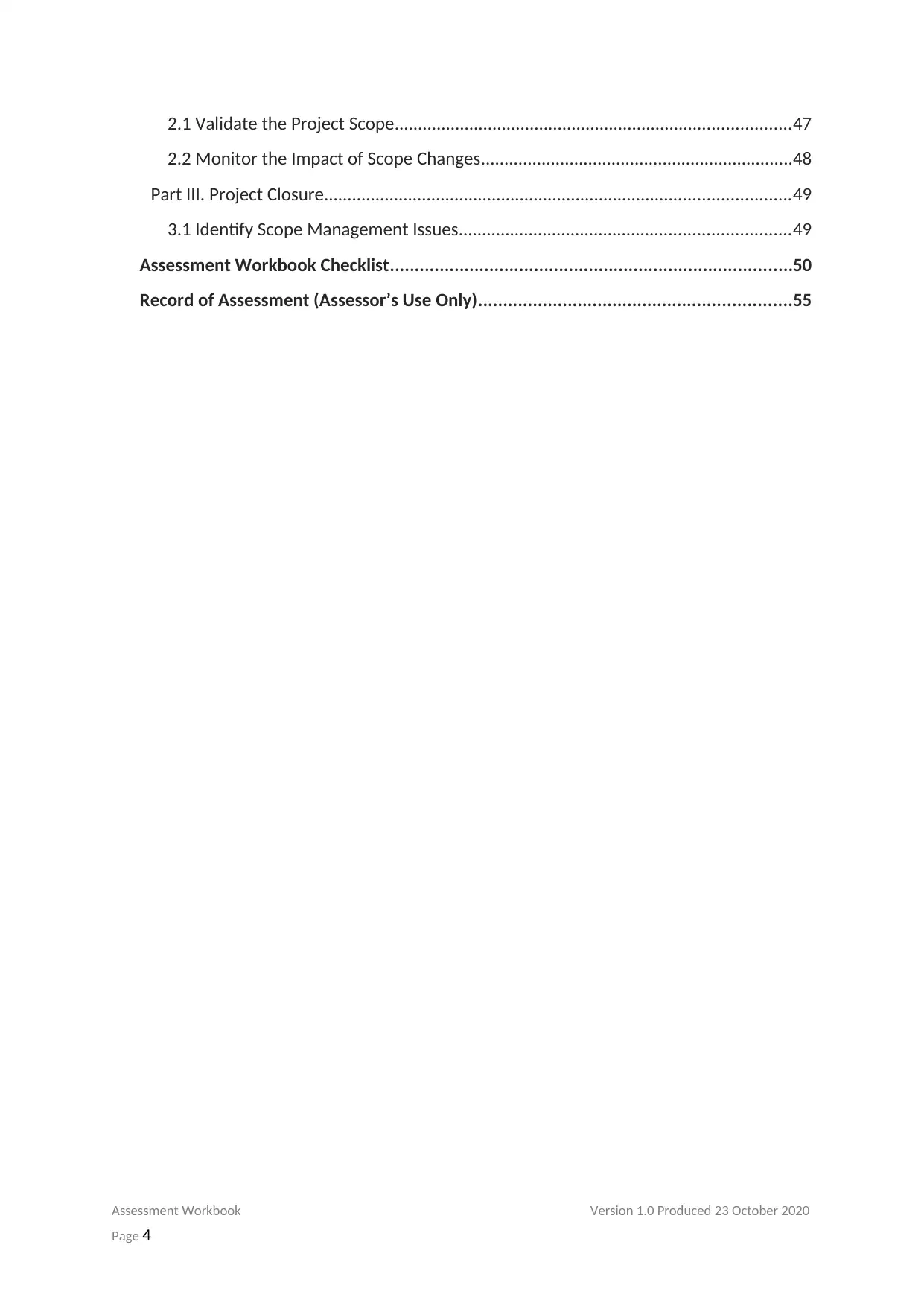
2.1 Validate the Project Scope.....................................................................................47
2.2 Monitor the Impact of Scope Changes...................................................................48
Part III. Project Closure....................................................................................................49
3.1 Identify Scope Management Issues.......................................................................49
Assessment Workbook Checklist.................................................................................50
Record of Assessment (Assessor’s Use Only)...............................................................55
Assessment Workbook Version 1.0 Produced 23 October 2020
Page 4
2.2 Monitor the Impact of Scope Changes...................................................................48
Part III. Project Closure....................................................................................................49
3.1 Identify Scope Management Issues.......................................................................49
Assessment Workbook Checklist.................................................................................50
Record of Assessment (Assessor’s Use Only)...............................................................55
Assessment Workbook Version 1.0 Produced 23 October 2020
Page 4
Paraphrase This Document
Need a fresh take? Get an instant paraphrase of this document with our AI Paraphraser
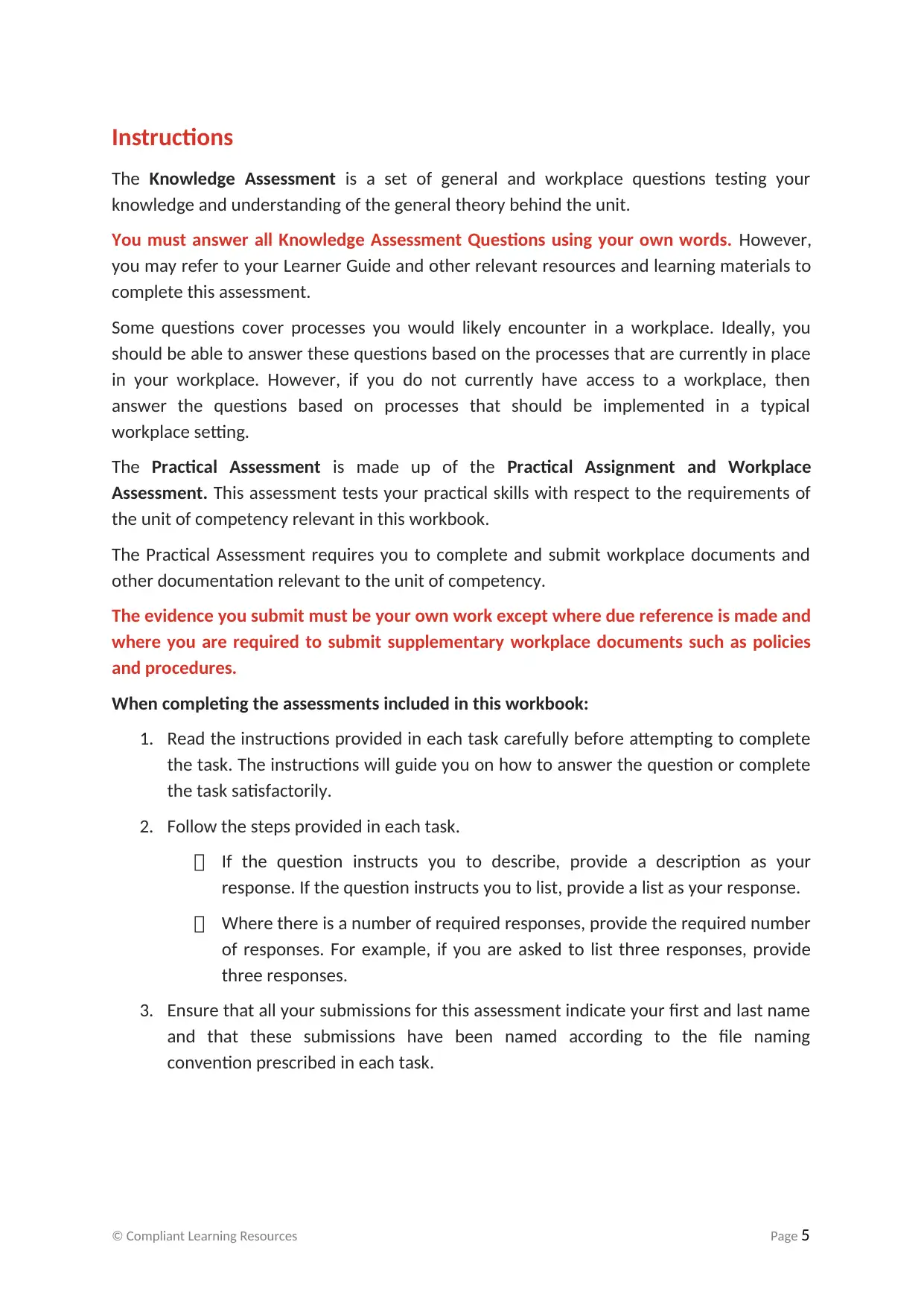
Instructions
The Knowledge Assessment is a set of general and workplace questions testing your
knowledge and understanding of the general theory behind the unit.
You must answer all Knowledge Assessment Questions using your own words. However,
you may refer to your Learner Guide and other relevant resources and learning materials to
complete this assessment.
Some questions cover processes you would likely encounter in a workplace. Ideally, you
should be able to answer these questions based on the processes that are currently in place
in your workplace. However, if you do not currently have access to a workplace, then
answer the questions based on processes that should be implemented in a typical
workplace setting.
The Practical Assessment is made up of the Practical Assignment and Workplace
Assessment. This assessment tests your practical skills with respect to the requirements of
the unit of competency relevant in this workbook.
The Practical Assessment requires you to complete and submit workplace documents and
other documentation relevant to the unit of competency.
The evidence you submit must be your own work except where due reference is made and
where you are required to submit supplementary workplace documents such as policies
and procedures.
When completing the assessments included in this workbook:
1. Read the instructions provided in each task carefully before attempting to complete
the task. The instructions will guide you on how to answer the question or complete
the task satisfactorily.
2. Follow the steps provided in each task.
If the question instructs you to describe, provide a description as your
response. If the question instructs you to list, provide a list as your response.
Where there is a number of required responses, provide the required number
of responses. For example, if you are asked to list three responses, provide
three responses.
3. Ensure that all your submissions for this assessment indicate your first and last name
and that these submissions have been named according to the file naming
convention prescribed in each task.
© Compliant Learning Resources Page 5
The Knowledge Assessment is a set of general and workplace questions testing your
knowledge and understanding of the general theory behind the unit.
You must answer all Knowledge Assessment Questions using your own words. However,
you may refer to your Learner Guide and other relevant resources and learning materials to
complete this assessment.
Some questions cover processes you would likely encounter in a workplace. Ideally, you
should be able to answer these questions based on the processes that are currently in place
in your workplace. However, if you do not currently have access to a workplace, then
answer the questions based on processes that should be implemented in a typical
workplace setting.
The Practical Assessment is made up of the Practical Assignment and Workplace
Assessment. This assessment tests your practical skills with respect to the requirements of
the unit of competency relevant in this workbook.
The Practical Assessment requires you to complete and submit workplace documents and
other documentation relevant to the unit of competency.
The evidence you submit must be your own work except where due reference is made and
where you are required to submit supplementary workplace documents such as policies
and procedures.
When completing the assessments included in this workbook:
1. Read the instructions provided in each task carefully before attempting to complete
the task. The instructions will guide you on how to answer the question or complete
the task satisfactorily.
2. Follow the steps provided in each task.
If the question instructs you to describe, provide a description as your
response. If the question instructs you to list, provide a list as your response.
Where there is a number of required responses, provide the required number
of responses. For example, if you are asked to list three responses, provide
three responses.
3. Ensure that all your submissions for this assessment indicate your first and last name
and that these submissions have been named according to the file naming
convention prescribed in each task.
© Compliant Learning Resources Page 5
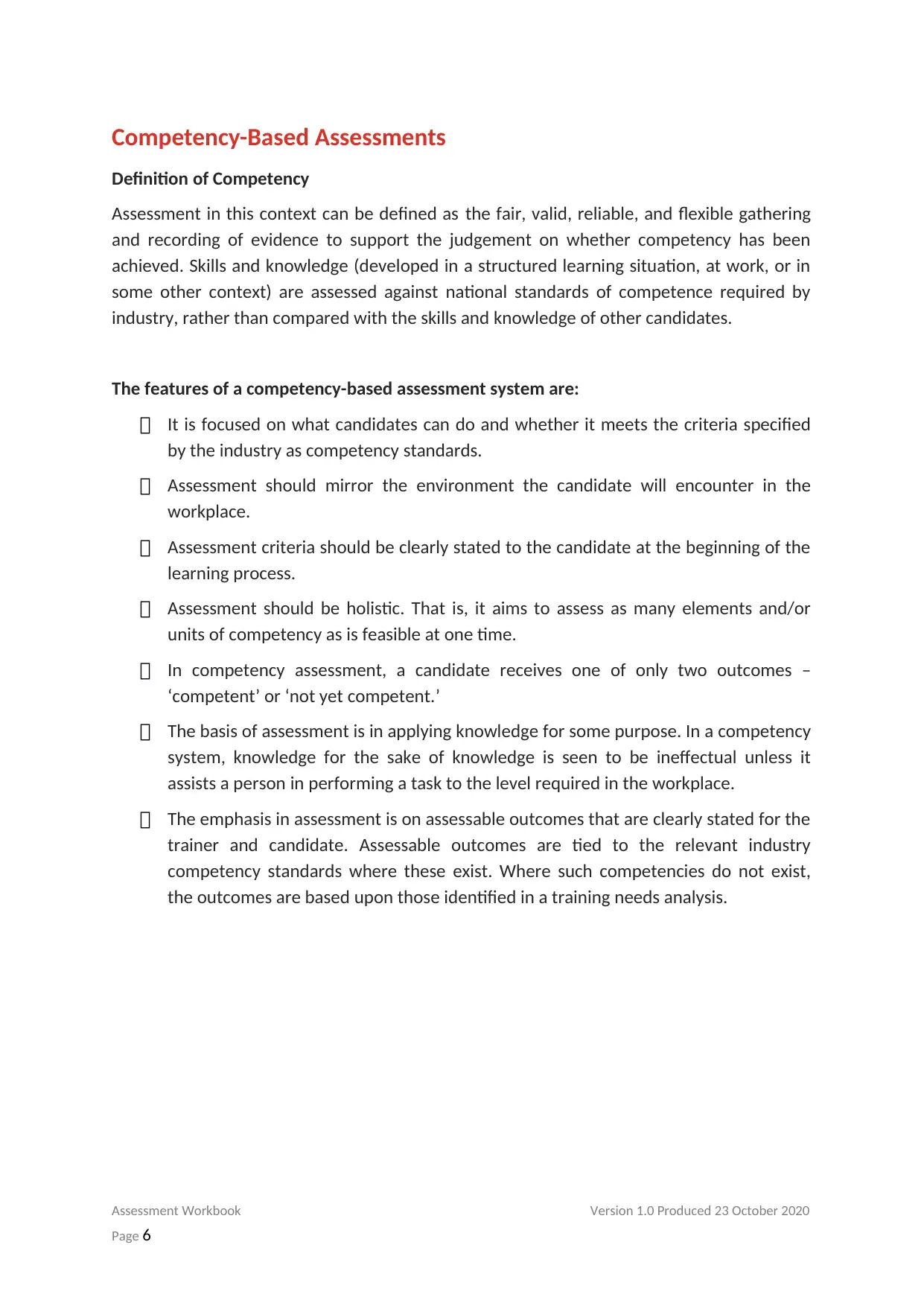
Competency-Based Assessments
Definition of Competency
Assessment in this context can be defined as the fair, valid, reliable, and flexible gathering
and recording of evidence to support the judgement on whether competency has been
achieved. Skills and knowledge (developed in a structured learning situation, at work, or in
some other context) are assessed against national standards of competence required by
industry, rather than compared with the skills and knowledge of other candidates.
The features of a competency-based assessment system are:
It is focused on what candidates can do and whether it meets the criteria specified
by the industry as competency standards.
Assessment should mirror the environment the candidate will encounter in the
workplace.
Assessment criteria should be clearly stated to the candidate at the beginning of the
learning process.
Assessment should be holistic. That is, it aims to assess as many elements and/or
units of competency as is feasible at one time.
In competency assessment, a candidate receives one of only two outcomes –
‘competent’ or ‘not yet competent.’
The basis of assessment is in applying knowledge for some purpose. In a competency
system, knowledge for the sake of knowledge is seen to be ineffectual unless it
assists a person in performing a task to the level required in the workplace.
The emphasis in assessment is on assessable outcomes that are clearly stated for the
trainer and candidate. Assessable outcomes are tied to the relevant industry
competency standards where these exist. Where such competencies do not exist,
the outcomes are based upon those identified in a training needs analysis.
Assessment Workbook Version 1.0 Produced 23 October 2020
Page 6
Definition of Competency
Assessment in this context can be defined as the fair, valid, reliable, and flexible gathering
and recording of evidence to support the judgement on whether competency has been
achieved. Skills and knowledge (developed in a structured learning situation, at work, or in
some other context) are assessed against national standards of competence required by
industry, rather than compared with the skills and knowledge of other candidates.
The features of a competency-based assessment system are:
It is focused on what candidates can do and whether it meets the criteria specified
by the industry as competency standards.
Assessment should mirror the environment the candidate will encounter in the
workplace.
Assessment criteria should be clearly stated to the candidate at the beginning of the
learning process.
Assessment should be holistic. That is, it aims to assess as many elements and/or
units of competency as is feasible at one time.
In competency assessment, a candidate receives one of only two outcomes –
‘competent’ or ‘not yet competent.’
The basis of assessment is in applying knowledge for some purpose. In a competency
system, knowledge for the sake of knowledge is seen to be ineffectual unless it
assists a person in performing a task to the level required in the workplace.
The emphasis in assessment is on assessable outcomes that are clearly stated for the
trainer and candidate. Assessable outcomes are tied to the relevant industry
competency standards where these exist. Where such competencies do not exist,
the outcomes are based upon those identified in a training needs analysis.
Assessment Workbook Version 1.0 Produced 23 October 2020
Page 6
⊘ This is a preview!⊘
Do you want full access?
Subscribe today to unlock all pages.

Trusted by 1+ million students worldwide
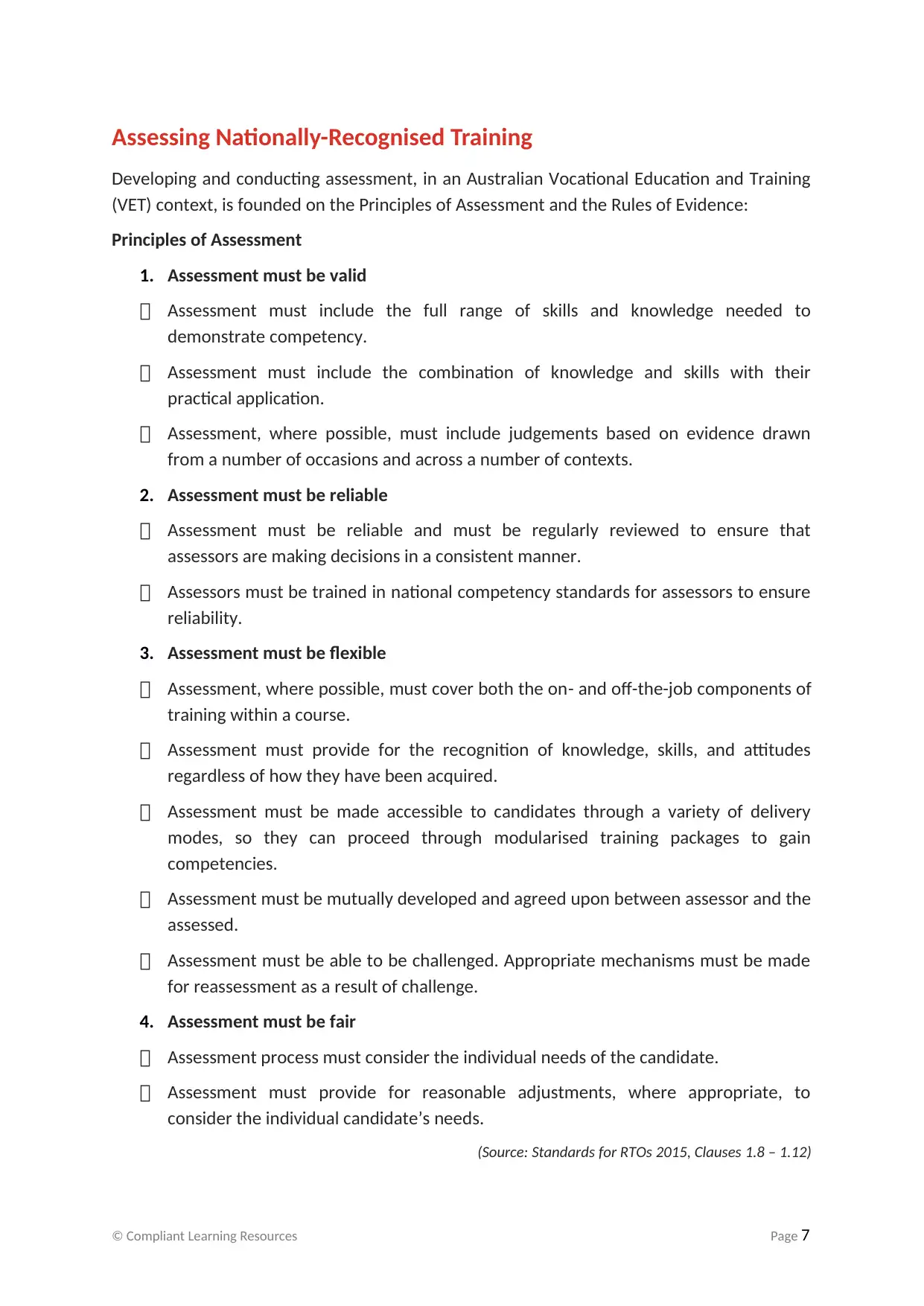
Assessing Nationally-Recognised Training
Developing and conducting assessment, in an Australian Vocational Education and Training
(VET) context, is founded on the Principles of Assessment and the Rules of Evidence:
Principles of Assessment
1. Assessment must be valid
Assessment must include the full range of skills and knowledge needed to
demonstrate competency.
Assessment must include the combination of knowledge and skills with their
practical application.
Assessment, where possible, must include judgements based on evidence drawn
from a number of occasions and across a number of contexts.
2. Assessment must be reliable
Assessment must be reliable and must be regularly reviewed to ensure that
assessors are making decisions in a consistent manner.
Assessors must be trained in national competency standards for assessors to ensure
reliability.
3. Assessment must be flexible
Assessment, where possible, must cover both the on- and off-the-job components of
training within a course.
Assessment must provide for the recognition of knowledge, skills, and attitudes
regardless of how they have been acquired.
Assessment must be made accessible to candidates through a variety of delivery
modes, so they can proceed through modularised training packages to gain
competencies.
Assessment must be mutually developed and agreed upon between assessor and the
assessed.
Assessment must be able to be challenged. Appropriate mechanisms must be made
for reassessment as a result of challenge.
4. Assessment must be fair
Assessment process must consider the individual needs of the candidate.
Assessment must provide for reasonable adjustments, where appropriate, to
consider the individual candidate’s needs.
(Source: Standards for RTOs 2015, Clauses 1.8 – 1.12)
© Compliant Learning Resources Page 7
Developing and conducting assessment, in an Australian Vocational Education and Training
(VET) context, is founded on the Principles of Assessment and the Rules of Evidence:
Principles of Assessment
1. Assessment must be valid
Assessment must include the full range of skills and knowledge needed to
demonstrate competency.
Assessment must include the combination of knowledge and skills with their
practical application.
Assessment, where possible, must include judgements based on evidence drawn
from a number of occasions and across a number of contexts.
2. Assessment must be reliable
Assessment must be reliable and must be regularly reviewed to ensure that
assessors are making decisions in a consistent manner.
Assessors must be trained in national competency standards for assessors to ensure
reliability.
3. Assessment must be flexible
Assessment, where possible, must cover both the on- and off-the-job components of
training within a course.
Assessment must provide for the recognition of knowledge, skills, and attitudes
regardless of how they have been acquired.
Assessment must be made accessible to candidates through a variety of delivery
modes, so they can proceed through modularised training packages to gain
competencies.
Assessment must be mutually developed and agreed upon between assessor and the
assessed.
Assessment must be able to be challenged. Appropriate mechanisms must be made
for reassessment as a result of challenge.
4. Assessment must be fair
Assessment process must consider the individual needs of the candidate.
Assessment must provide for reasonable adjustments, where appropriate, to
consider the individual candidate’s needs.
(Source: Standards for RTOs 2015, Clauses 1.8 – 1.12)
© Compliant Learning Resources Page 7
Paraphrase This Document
Need a fresh take? Get an instant paraphrase of this document with our AI Paraphraser
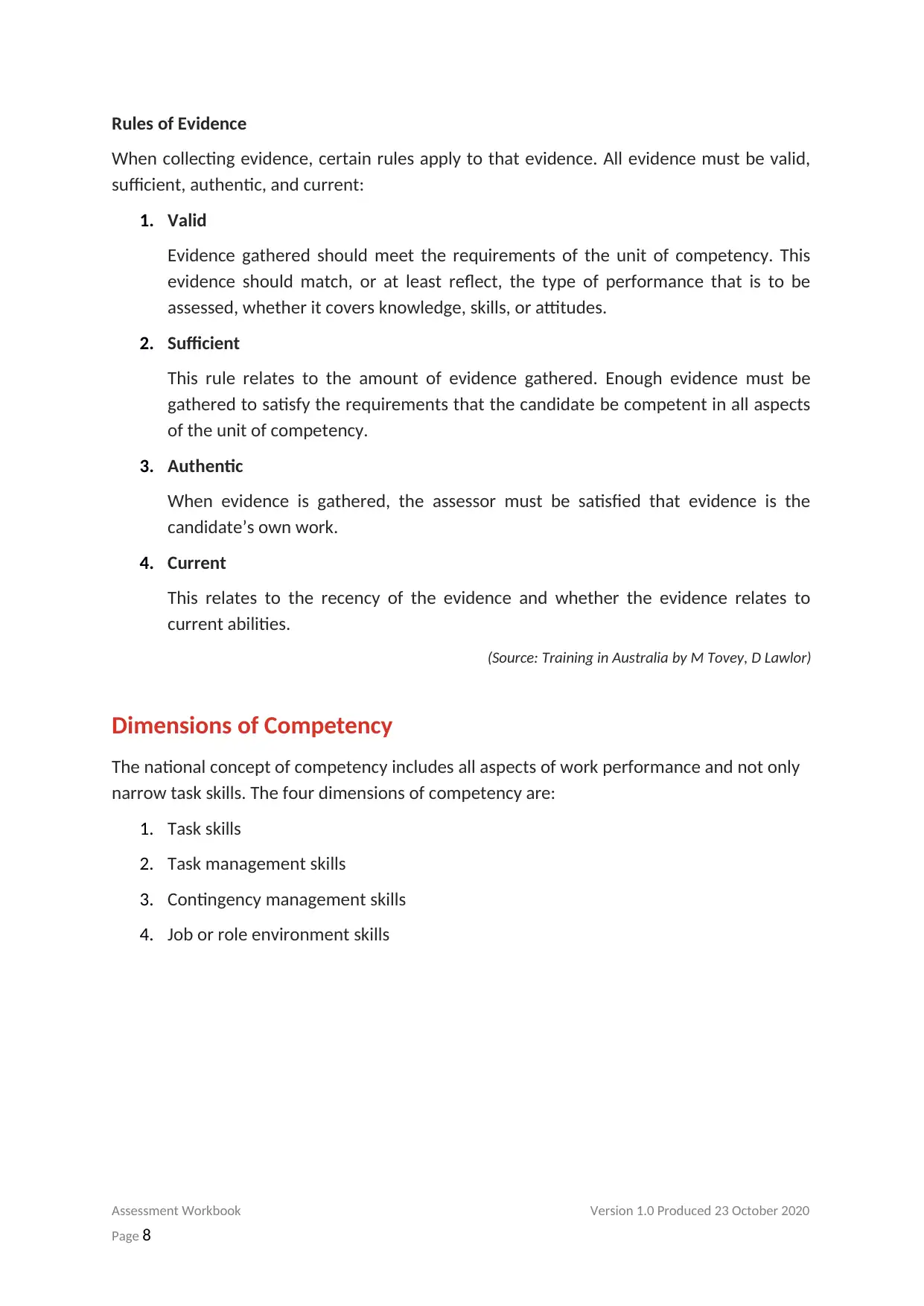
Rules of Evidence
When collecting evidence, certain rules apply to that evidence. All evidence must be valid,
sufficient, authentic, and current:
1. Valid
Evidence gathered should meet the requirements of the unit of competency. This
evidence should match, or at least reflect, the type of performance that is to be
assessed, whether it covers knowledge, skills, or attitudes.
2. Sufficient
This rule relates to the amount of evidence gathered. Enough evidence must be
gathered to satisfy the requirements that the candidate be competent in all aspects
of the unit of competency.
3. Authentic
When evidence is gathered, the assessor must be satisfied that evidence is the
candidate’s own work.
4. Current
This relates to the recency of the evidence and whether the evidence relates to
current abilities.
(Source: Training in Australia by M Tovey, D Lawlor)
Dimensions of Competency
The national concept of competency includes all aspects of work performance and not only
narrow task skills. The four dimensions of competency are:
1. Task skills
2. Task management skills
3. Contingency management skills
4. Job or role environment skills
Assessment Workbook Version 1.0 Produced 23 October 2020
Page 8
When collecting evidence, certain rules apply to that evidence. All evidence must be valid,
sufficient, authentic, and current:
1. Valid
Evidence gathered should meet the requirements of the unit of competency. This
evidence should match, or at least reflect, the type of performance that is to be
assessed, whether it covers knowledge, skills, or attitudes.
2. Sufficient
This rule relates to the amount of evidence gathered. Enough evidence must be
gathered to satisfy the requirements that the candidate be competent in all aspects
of the unit of competency.
3. Authentic
When evidence is gathered, the assessor must be satisfied that evidence is the
candidate’s own work.
4. Current
This relates to the recency of the evidence and whether the evidence relates to
current abilities.
(Source: Training in Australia by M Tovey, D Lawlor)
Dimensions of Competency
The national concept of competency includes all aspects of work performance and not only
narrow task skills. The four dimensions of competency are:
1. Task skills
2. Task management skills
3. Contingency management skills
4. Job or role environment skills
Assessment Workbook Version 1.0 Produced 23 October 2020
Page 8
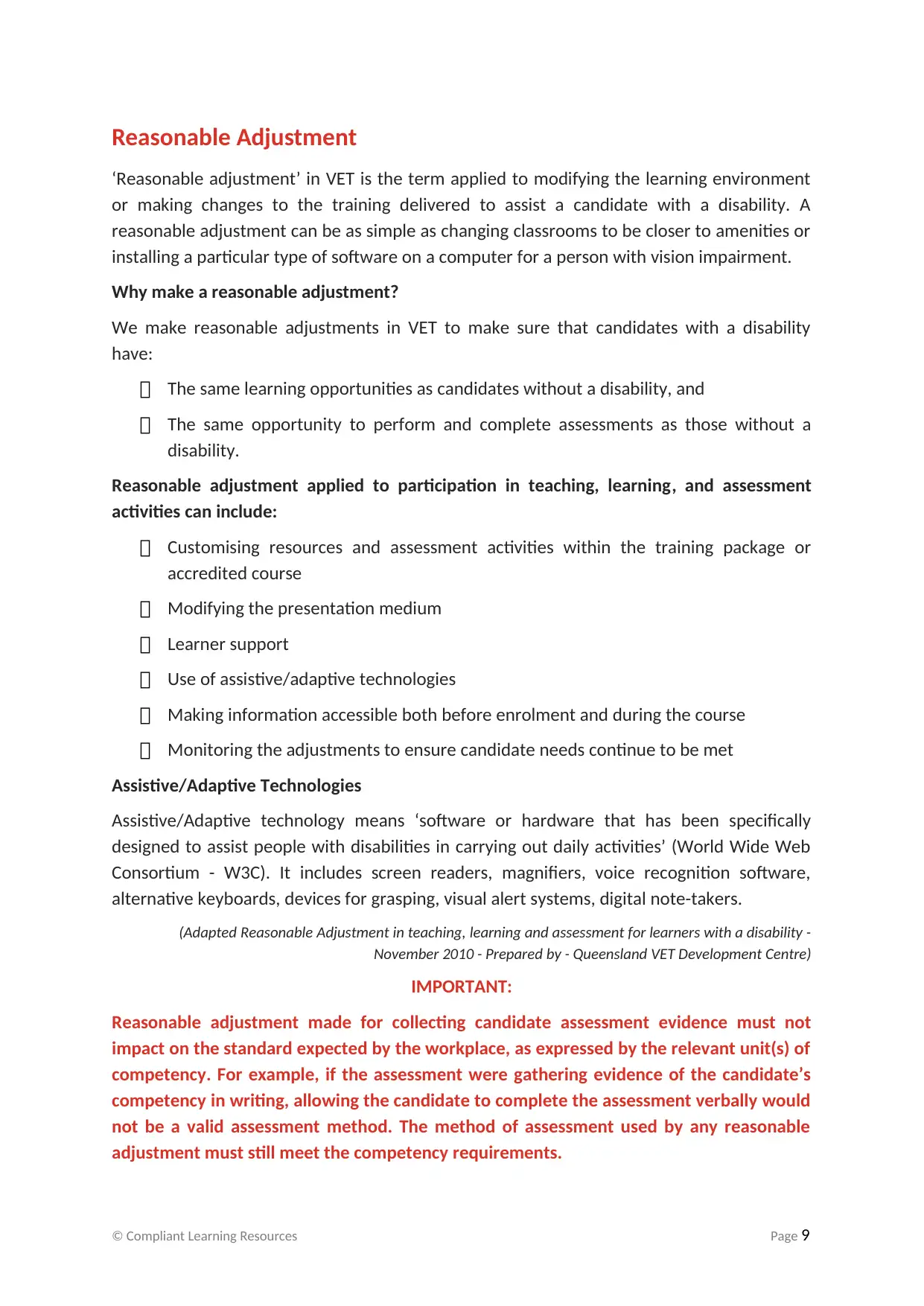
Reasonable Adjustment
‘Reasonable adjustment’ in VET is the term applied to modifying the learning environment
or making changes to the training delivered to assist a candidate with a disability. A
reasonable adjustment can be as simple as changing classrooms to be closer to amenities or
installing a particular type of software on a computer for a person with vision impairment.
Why make a reasonable adjustment?
We make reasonable adjustments in VET to make sure that candidates with a disability
have:
The same learning opportunities as candidates without a disability, and
The same opportunity to perform and complete assessments as those without a
disability.
Reasonable adjustment applied to participation in teaching, learning, and assessment
activities can include:
Customising resources and assessment activities within the training package or
accredited course
Modifying the presentation medium
Learner support
Use of assistive/adaptive technologies
Making information accessible both before enrolment and during the course
Monitoring the adjustments to ensure candidate needs continue to be met
Assistive/Adaptive Technologies
Assistive/Adaptive technology means ‘software or hardware that has been specifically
designed to assist people with disabilities in carrying out daily activities’ (World Wide Web
Consortium - W3C). It includes screen readers, magnifiers, voice recognition software,
alternative keyboards, devices for grasping, visual alert systems, digital note-takers.
(Adapted Reasonable Adjustment in teaching, learning and assessment for learners with a disability -
November 2010 - Prepared by - Queensland VET Development Centre)
IMPORTANT:
Reasonable adjustment made for collecting candidate assessment evidence must not
impact on the standard expected by the workplace, as expressed by the relevant unit(s) of
competency. For example, if the assessment were gathering evidence of the candidate’s
competency in writing, allowing the candidate to complete the assessment verbally would
not be a valid assessment method. The method of assessment used by any reasonable
adjustment must still meet the competency requirements.
© Compliant Learning Resources Page 9
‘Reasonable adjustment’ in VET is the term applied to modifying the learning environment
or making changes to the training delivered to assist a candidate with a disability. A
reasonable adjustment can be as simple as changing classrooms to be closer to amenities or
installing a particular type of software on a computer for a person with vision impairment.
Why make a reasonable adjustment?
We make reasonable adjustments in VET to make sure that candidates with a disability
have:
The same learning opportunities as candidates without a disability, and
The same opportunity to perform and complete assessments as those without a
disability.
Reasonable adjustment applied to participation in teaching, learning, and assessment
activities can include:
Customising resources and assessment activities within the training package or
accredited course
Modifying the presentation medium
Learner support
Use of assistive/adaptive technologies
Making information accessible both before enrolment and during the course
Monitoring the adjustments to ensure candidate needs continue to be met
Assistive/Adaptive Technologies
Assistive/Adaptive technology means ‘software or hardware that has been specifically
designed to assist people with disabilities in carrying out daily activities’ (World Wide Web
Consortium - W3C). It includes screen readers, magnifiers, voice recognition software,
alternative keyboards, devices for grasping, visual alert systems, digital note-takers.
(Adapted Reasonable Adjustment in teaching, learning and assessment for learners with a disability -
November 2010 - Prepared by - Queensland VET Development Centre)
IMPORTANT:
Reasonable adjustment made for collecting candidate assessment evidence must not
impact on the standard expected by the workplace, as expressed by the relevant unit(s) of
competency. For example, if the assessment were gathering evidence of the candidate’s
competency in writing, allowing the candidate to complete the assessment verbally would
not be a valid assessment method. The method of assessment used by any reasonable
adjustment must still meet the competency requirements.
© Compliant Learning Resources Page 9
⊘ This is a preview!⊘
Do you want full access?
Subscribe today to unlock all pages.

Trusted by 1+ million students worldwide
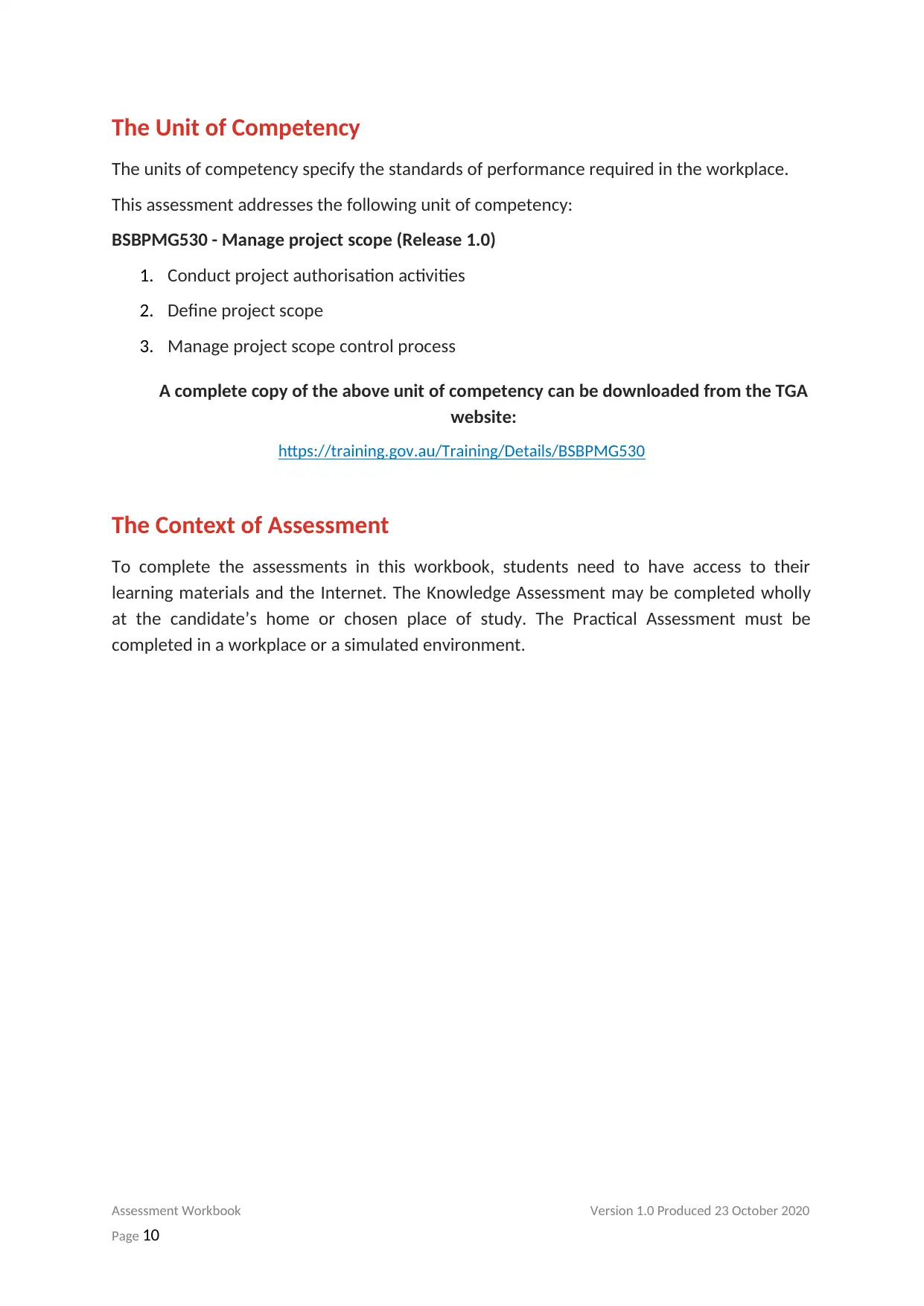
The Unit of Competency
The units of competency specify the standards of performance required in the workplace.
This assessment addresses the following unit of competency:
BSBPMG530 - Manage project scope (Release 1.0)
1. Conduct project authorisation activities
2. Define project scope
3. Manage project scope control process
A complete copy of the above unit of competency can be downloaded from the TGA
website:
https://training.gov.au/Training/Details/BSBPMG530
The Context of Assessment
To complete the assessments in this workbook, students need to have access to their
learning materials and the Internet. The Knowledge Assessment may be completed wholly
at the candidate’s home or chosen place of study. The Practical Assessment must be
completed in a workplace or a simulated environment.
Assessment Workbook Version 1.0 Produced 23 October 2020
Page 10
The units of competency specify the standards of performance required in the workplace.
This assessment addresses the following unit of competency:
BSBPMG530 - Manage project scope (Release 1.0)
1. Conduct project authorisation activities
2. Define project scope
3. Manage project scope control process
A complete copy of the above unit of competency can be downloaded from the TGA
website:
https://training.gov.au/Training/Details/BSBPMG530
The Context of Assessment
To complete the assessments in this workbook, students need to have access to their
learning materials and the Internet. The Knowledge Assessment may be completed wholly
at the candidate’s home or chosen place of study. The Practical Assessment must be
completed in a workplace or a simulated environment.
Assessment Workbook Version 1.0 Produced 23 October 2020
Page 10
Paraphrase This Document
Need a fresh take? Get an instant paraphrase of this document with our AI Paraphraser
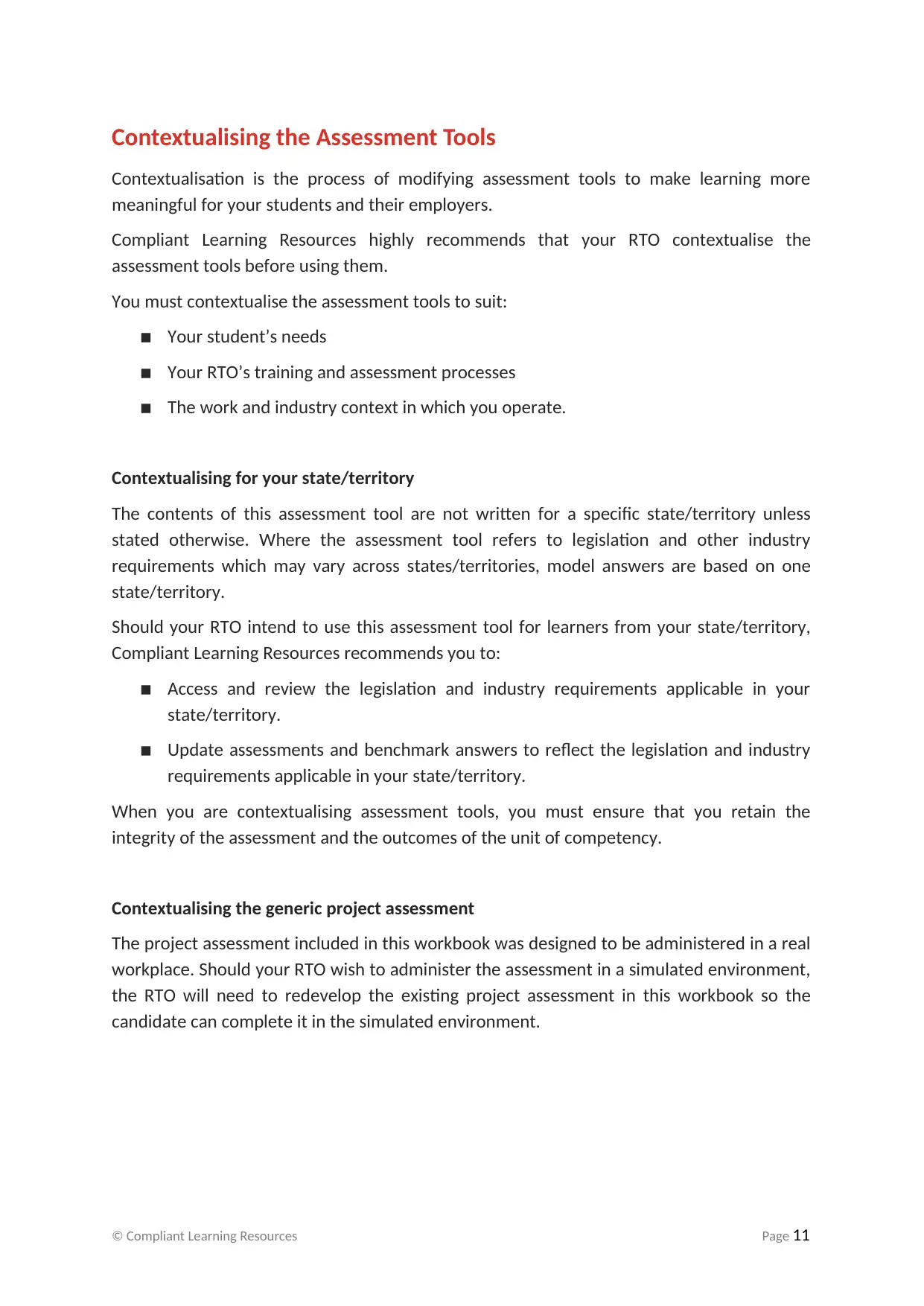
Contextualising the Assessment Tools
Contextualisation is the process of modifying assessment tools to make learning more
meaningful for your students and their employers.
Compliant Learning Resources highly recommends that your RTO contextualise the
assessment tools before using them.
You must contextualise the assessment tools to suit:
▪ Your student’s needs
▪ Your RTO’s training and assessment processes
▪ The work and industry context in which you operate.
Contextualising for your state/territory
The contents of this assessment tool are not written for a specific state/territory unless
stated otherwise. Where the assessment tool refers to legislation and other industry
requirements which may vary across states/territories, model answers are based on one
state/territory.
Should your RTO intend to use this assessment tool for learners from your state/territory,
Compliant Learning Resources recommends you to:
▪ Access and review the legislation and industry requirements applicable in your
state/territory.
▪ Update assessments and benchmark answers to reflect the legislation and industry
requirements applicable in your state/territory.
When you are contextualising assessment tools, you must ensure that you retain the
integrity of the assessment and the outcomes of the unit of competency.
Contextualising the generic project assessment
The project assessment included in this workbook was designed to be administered in a real
workplace. Should your RTO wish to administer the assessment in a simulated environment,
the RTO will need to redevelop the existing project assessment in this workbook so the
candidate can complete it in the simulated environment.
© Compliant Learning Resources Page 11
Contextualisation is the process of modifying assessment tools to make learning more
meaningful for your students and their employers.
Compliant Learning Resources highly recommends that your RTO contextualise the
assessment tools before using them.
You must contextualise the assessment tools to suit:
▪ Your student’s needs
▪ Your RTO’s training and assessment processes
▪ The work and industry context in which you operate.
Contextualising for your state/territory
The contents of this assessment tool are not written for a specific state/territory unless
stated otherwise. Where the assessment tool refers to legislation and other industry
requirements which may vary across states/territories, model answers are based on one
state/territory.
Should your RTO intend to use this assessment tool for learners from your state/territory,
Compliant Learning Resources recommends you to:
▪ Access and review the legislation and industry requirements applicable in your
state/territory.
▪ Update assessments and benchmark answers to reflect the legislation and industry
requirements applicable in your state/territory.
When you are contextualising assessment tools, you must ensure that you retain the
integrity of the assessment and the outcomes of the unit of competency.
Contextualising the generic project assessment
The project assessment included in this workbook was designed to be administered in a real
workplace. Should your RTO wish to administer the assessment in a simulated environment,
the RTO will need to redevelop the existing project assessment in this workbook so the
candidate can complete it in the simulated environment.
© Compliant Learning Resources Page 11
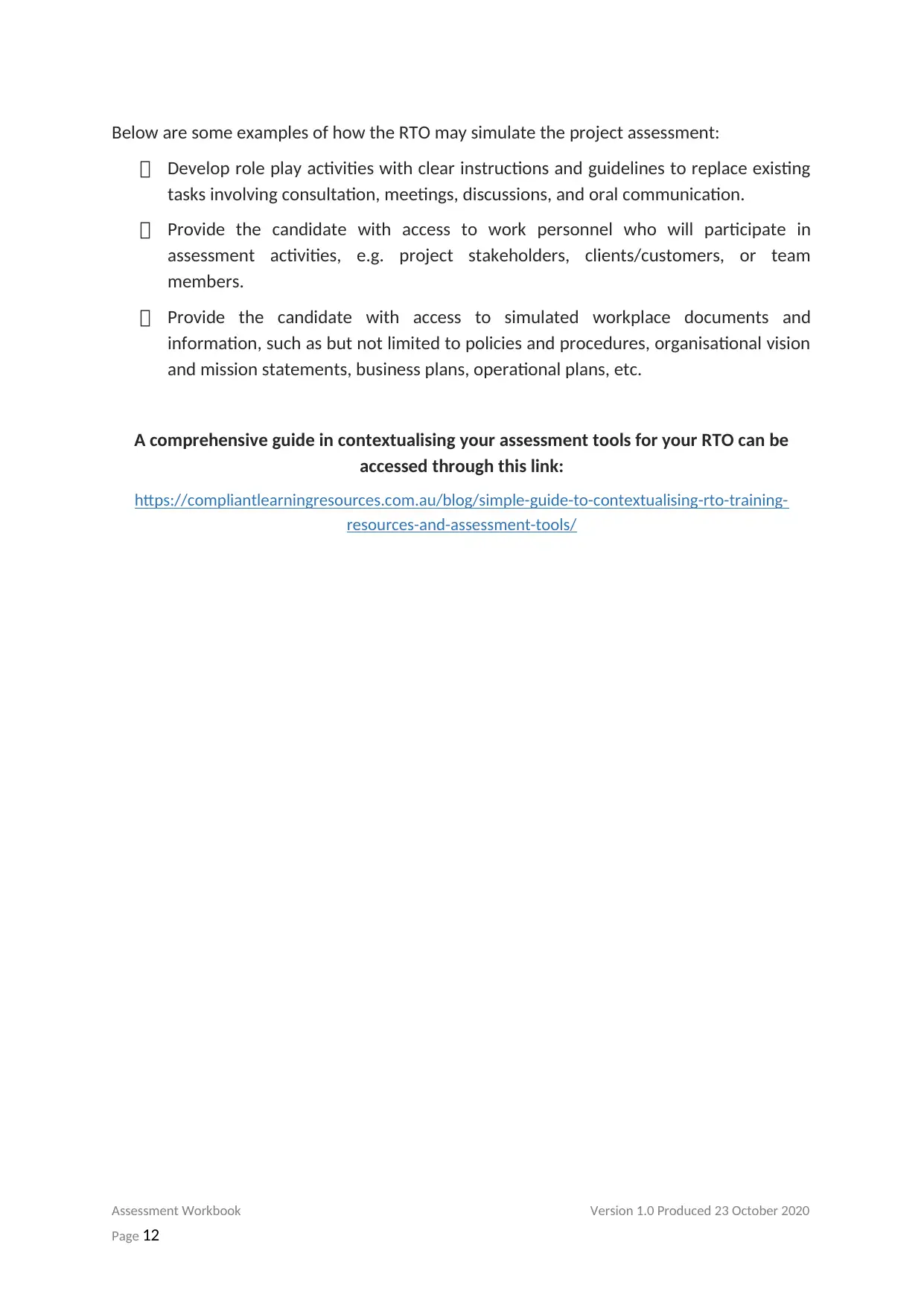
Below are some examples of how the RTO may simulate the project assessment:
Develop role play activities with clear instructions and guidelines to replace existing
tasks involving consultation, meetings, discussions, and oral communication.
Provide the candidate with access to work personnel who will participate in
assessment activities, e.g. project stakeholders, clients/customers, or team
members.
Provide the candidate with access to simulated workplace documents and
information, such as but not limited to policies and procedures, organisational vision
and mission statements, business plans, operational plans, etc.
A comprehensive guide in contextualising your assessment tools for your RTO can be
accessed through this link:
https://compliantlearningresources.com.au/blog/simple-guide-to-contextualising-rto-training-
resources-and-assessment-tools/
Assessment Workbook Version 1.0 Produced 23 October 2020
Page 12
Develop role play activities with clear instructions and guidelines to replace existing
tasks involving consultation, meetings, discussions, and oral communication.
Provide the candidate with access to work personnel who will participate in
assessment activities, e.g. project stakeholders, clients/customers, or team
members.
Provide the candidate with access to simulated workplace documents and
information, such as but not limited to policies and procedures, organisational vision
and mission statements, business plans, operational plans, etc.
A comprehensive guide in contextualising your assessment tools for your RTO can be
accessed through this link:
https://compliantlearningresources.com.au/blog/simple-guide-to-contextualising-rto-training-
resources-and-assessment-tools/
Assessment Workbook Version 1.0 Produced 23 October 2020
Page 12
⊘ This is a preview!⊘
Do you want full access?
Subscribe today to unlock all pages.

Trusted by 1+ million students worldwide
1 out of 69
Related Documents
Your All-in-One AI-Powered Toolkit for Academic Success.
+13062052269
info@desklib.com
Available 24*7 on WhatsApp / Email
![[object Object]](/_next/static/media/star-bottom.7253800d.svg)
Unlock your academic potential
Copyright © 2020–2025 A2Z Services. All Rights Reserved. Developed and managed by ZUCOL.





